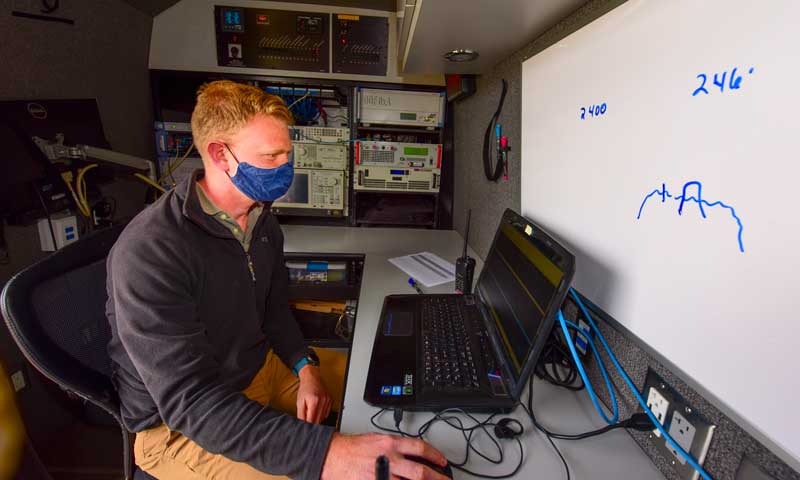For nearly 20 years, the Naval Postgraduate School’s Joint Interagency Field Experimentation (JIFX) program has hosted quarterly in person experimentation events at the NPS Field Lab located at Camp Roberts, California. The events fostered collaboration between military, commercial industry and academia to experiment with and evaluate emerging technologies.
In response to the COVID-19 pandemic, the JIFX team led by Dr. Raymond Buettner, NPS Associate Professor of Information Sciences, facilitated a shift to a completely virtual format, like countless organizations committed to their mission were required to do. And there were advantages to the approach that extended the reach and the value of the event.
Demonstrating the team’s adaptability, the latest JIFX 21-2 event was completed as a hybrid event bringing together a nationally-distributed audience virtually to exchange insights on emerging technology, and participate in a live collaborative experiment with the exchange of critical data and imagery in real time.
A total of 325 participants representing 208 unique government agencies, military commands, and private companies were able to showcase their latest technologies, and in some cases test and evaluate them either in simulation or live on location at the NPS Field Lab at Camp Roberts with ground and airspace availability.
According to Buettner, the ready accessibility of the virtual format garnered JIFX 21-2 the largest span of participants a JIFX event has ever had. The silver lining to operating in a virtual environment was that participants who normally could not make the event physically were able to join online to make virtual presentations, have detailed conversations and be involved in the virtual Technology Exposition (TechExpo) portion of JIFX, which is all about evaluating potential new or improved capabilities for the warfighter.
JIFX Deputy Director Michael Richardson noted, "Our goal is to continue refining our capabilities to host hybrid events in the future where the central focus will be live, in person, experimentation at our field laboratories, which facilitates great collaboration between the experimenters, while also linking those activities with other research, commercial, and military audiences through the virtual capabilities we have proven over the last year."
The online events, included the TechExpo, consisted of demonstrations on, and in-depth conversations about, emerging technologies. During the TechExpo, companies discussed and demonstrated projects such as an augmented reality (AR) contact lens that could potentially allow the warfighter to have an overlay of pertinent information over the real world without obstructing vision, while another company presented a new mask with the potential to provide enhanced filtration for viruses and bacteria.
A major line of experimentation for JIFX is Unmanned Vehicles and Autonomous Systems (UVAS). For JIFX 21-2, the co-directors of the Navy’s UVAS Working Group spoke to the government representative. Leading that discussion was Reid McAllister, Director of Integrate Maritime Mobility Systems at Naval Surface Warfare Center Carderock Division.
"Our membership is supporting nearly every unmanned product that the naval forces have in their pipeline,” said McAllister. “We have subject matter expertise from NAVAIR, Naval Sea Systems Command and certainly Naval Information Warfare Systems commands. The partnership with Naval Postgraduate School, and Sea Land Air Military Research Initiative (SLAMR) has been highly effective. Ultimately, what we're trying to do is align [participants] with the national and naval force’s strategic objectives.
“NPS is really helping us out is when you start getting into that private industry and academia and the outreach that they greatly afford us,” he noted.
McAllister further noted this enterprise accelerates the delivery of new capabilities to the warfighter while fostering a one-team collaboration effort incorporating high-velocity learning principles.
While the virtual events were ongoing, creative minds like NPS researcher Aurelio Monarrez and student U.S. Marine Corps Capt. Luke Klena, were conducting live experimentation at the NPS Field Laboratory. Their work in the field involved mitigation of Radio Frequency (RF) in combat scenarios with the help of the Joint Vulnerability Assessment Branch (JVAB), a mainstay at JFIX that assesses and identifies security vulnerabilities in RF and computer networks.
"JIFX provides students unique and relevant research [oriented] for warfighters, and its relevancy comes from industry, DOD and warfighters all out here together at a low-cost barrier,” said Monarrez.
The technological experiments in the field are in an early enough stage, Monarrez added, that the researchers and students can provide feedback to the agencies and companies fielding the technology for potential modifications.
For Klena, he noted that he and his fellow students didn’t realize what JIFX and NPS’ Field Lab could do for them until they were actually on the ground there. Access to research assets, ground space, and air space were made available, giving them chance to translate theoretical work into applied research and hands-on experience.
Buettner added that collaboration is the key to JIFX. The evaluation of divergent perspectives in defense, industry and academia force a comprehensive analysis by the tech providers, leading to a very concise understanding of how the technology responds to national security and why is it worth the investment in manpower, material, facilities and time.
“The JIFX environment not only maximizes discovery but it enables the development of solutions,” said Buettner. “Along the way JIFX creates a unique, militarily relevant environment for educating future leaders regarding not only emerging technologies but the human processes and networks that lead to success.”


